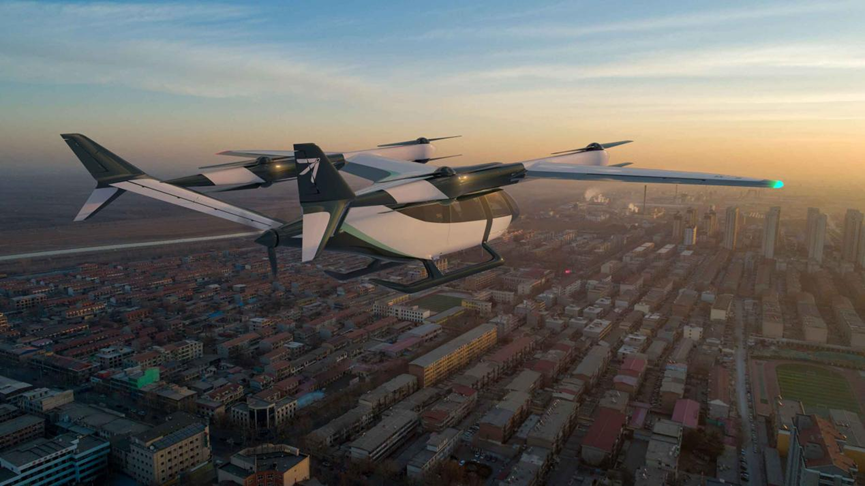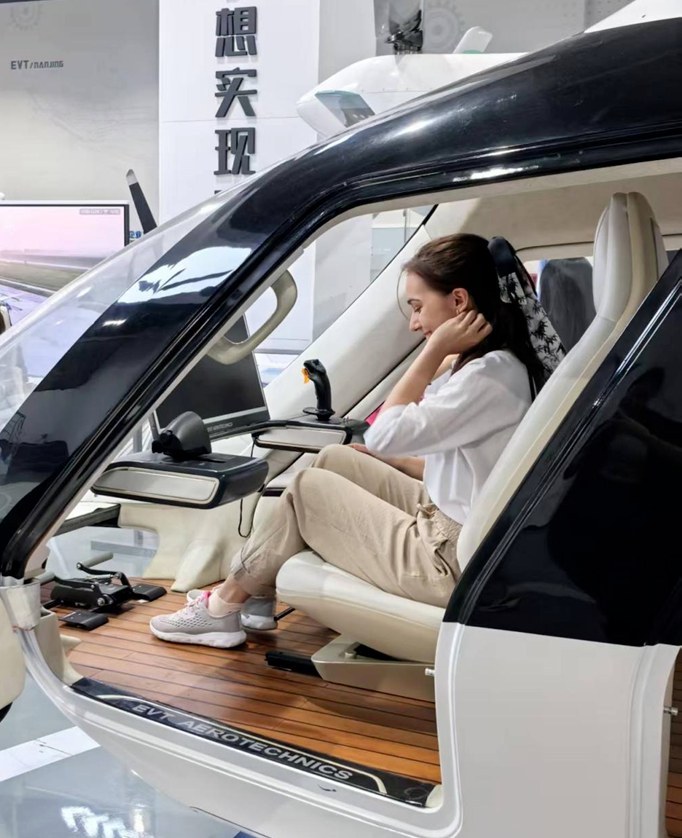EVT Aerotechnics, Led by Former COMAC Engineers, Secures Series A Funding for eVTOL Development

EVT Aerotechnics, an electric vertical take-off and landing (eVTOL) aircraft developer and manufacturer, has successfully completed a Series A funding round, securing hundreds of millions of yuan. The investment was led by Jinpu Investment, with participation from Jinggong Technology, Inbol Electric, Shengjing Jiacheng, and Ralph Ventures.
The newly acquired capital will primarily be allocated towards the research and development of EVT Aerotechnics' flagship models, airworthiness certification, the establishment of mass production capabilities for its Aviation Electric Propulsion System (EPS), and commercialisation validation for various scenarios.
Founded in 2022, EVT Aerotechnics boasts a core team originating from the Commercial Aircraft Corporation of China, Ltd. (COMAC). These seasoned engineers previously contributed to the development of domestic large aircraft models, including the Y-8 series, ARJ21, and C919. Founder Ren Wenguang brings nearly two decades of experience in aircraft design and validation. The company is dedicated to accelerating the development of Urban Air Mobility (UAM) and providing innovative solutions for future air travel.
According to Guojin Securities, China's cumulative demand for eVTOL aircraft is projected to reach 16,316 units by 2030, covering services such as short-haul scheduled passenger flights, corporate and private charters, aerial tourism, and medical transport. However, challenges like lengthy airworthiness certification cycles and low supply chain maturity continue to constrain commercialisation. While global leaders like Joby and Archer focus on passenger transport, domestic manufacturers such as EHang and AutoFlight primarily target scenic tours and cargo scenarios. Furthermore, core components like power systems still heavily rely on imports, with the procurement cost for a single motor ranging from hundreds of thousands to millions of yuan.

Introducing the ET9 and Future Innovations
EVT Aerotechnics' current core product is the ET9 series eVTOL. The ET9 is a five-person, four-seat passenger aircraft with a maximum take-off weight of 2.2 tons, a maximum range of 240 km, and a maximum speed of 240 km/h. It features a four-axis, eight-propeller compound wing configuration, characterised by a sleek and aesthetically pleasing design. The airframe utilises a modular design, with over 85% carbon fibre composite materials, resulting in a simple and lightweight structure.
Looking ahead, the company is also strategically developing the ET3 hydrogen-lithium hybrid energy model. This aircraft is designed for long-distance inspection and surveying, with an impressive range of up to 800 km, significantly expanding its operational scope and application potential.
Rapid Development and Domesticated Propulsion
EVT Aerotechnics has strategically chosen the compound wing configuration, which combines the flexibility of vertical take-off and landing with the extended range advantages of fixed-wing aircraft, making it suitable for logistics, urban shuttles, and other applications. The company's self-developed Aviation Electric Propulsion System (EPS) has achieved full localisation of motors, electronic controls, and propellers. Key performance indicators have been successfully tested, leading to a significant reduction in mass production costs compared to imported solutions.
Zhao Jiwei, co-founder of EVT Aerotechnics, highlighted the rapid development of the ET9 prototype, which took only 17 months from R&D to its first flight—a timeframe shorter than the industry average of 24-36 months. Notably, the prototype's maiden flight utilised the company's self-developed power system. Following its first flight, the aircraft has completed over 400 test flights, with the collected data being used for system validation, flight control algorithm optimisation, and structural lightweighting improvements.
The passenger version, designed for a 200 km range, is slated for airworthiness certification by 2027. The cargo version, with a 500 kg payload, is scheduled to commence a pilot program in 2026 with a shipping service company for offshore vessel supply, aiming to reduce transportation costs per trip by 60-70% compared to existing aviation solutions.
Addressing Core Challenges: Power Systems and Airworthiness
A primary challenge in the eVTOL industry is achieving autonomous and controllable core power systems. The current localisation rate for domestic eVTOL motors and electronic controls remains insufficient, leading to reliance on imports and unstable delivery times. EVT Aerotechnics addresses this by developing its own EPS and customising high-rate batteries, compressing the cost proportion of the power module to 32%. For 1-3 ton eVTOL aircraft, the company has developed a series of 50-100kW high-reliability, fully enclosed air-cooled, high torque density, and high-efficiency motors. The L50 series motor for 2-ton eVTOLs features an inner rotor and hybrid forced air cooling, boasts an IP67 protection rating, a peak single-propeller thrust exceeding 650 kg, a torque density over 33 N·m/kg, and a power density exceeding 5.0 kW/kg. The ET9 aircraft employs an eight-motor vertical take-off and landing power configuration with a multi-redundancy design, achieving a peak instantaneous thrust to hover thrust ratio exceeding 1.8, ensuring higher fault tolerance and safety.
Regarding airworthiness certification, the Type Certificate (TC) for EVT Aerotechnics' flagship model has been accepted, with cargo airworthiness certification anticipated in 2026 and passenger airworthiness certification in 2027. The company is collaborating with Nanjing University of Aeronautics and Astronautics to establish a simulation testing platform and has integrated a Civil Aviation Administration of China (CAAC) Designated Engineering Representative (DER) team, reducing the system validation cycle by 40% compared to the industry average. Concurrently, airspace management reforms are progressing, with EVT Aerotechnics successfully completing 10 take-offs and landings in a single day at a general aviation airport, validating the stability of its high-frequency dispatch system. Co-founder Zhang Zhi emphasised that the team's extensive experience within the civil aviation system provides a distinct advantage in designing for airworthiness compliance. While the safety standard for passenger models is set at 10⁻⁸, which is lower than civil airliners' 10⁻⁹, it significantly surpasses the safety threshold for drones, though achieving this still requires overcoming several challenges.
Strategic Commercialisation and Market Penetration
In line with recent national guidelines promoting the low-altitude economy—prioritizing cargo before passenger transport, segregated before integrated airspace, and suburban before urban operations—EVT Aerotechnics has adopted a "pre-order, scenario demonstration" commercialization strategy. This approach targets scenarios with strong policy support, rigid demand, and controllable risks. The company has established an operations centre and forged strategic partnerships with Didi Chuxing and Jianye to explore low-altitude operations.
EVT Aerotechnics has already signed over 300 Letters of Intent (LOIs), covering inspection aircraft, cargo drones, passenger eVTOLs, and "Air 120" emergency rescue services. For its cargo models, the company is exploring mountain and island chain logistics solutions with logistics enterprises. In the passenger sector, it has secured 30 "Air 120" emergency rescue orders, with potential partners including top-tier hospitals in the Yangtze River Delta region. For scenic shuttle services, an agreement for 50 units has been reached with a 5A-rated scenic area operator, with the first cross-mountain sightseeing route planned to open in 2026. Furthermore, EVT Aerotechnics plans to open its EPS power system supply to third-party aircraft manufacturers in 2026, with two domestic companies already expressing purchase intent.
Experienced Leadership Driving Innovation
The EVT Aerotechnics team is spearheaded by founder Ren Wenguang, a former Senior System Engineer for COMAC's C919. The core team also includes four senior researchers and several key personnel from the Y-8 series modification projects, with an average of over 15 years of industry experience. This founding team possesses strong overall integration capabilities and extensive type airworthiness experience. They employ a Model-Based Systems Engineering (MBSE) philosophy, utilising the RFLP (Requirements, Functional, Logical, Physical) system engineering forward design process as their methodology to build an integrated aircraft development system.